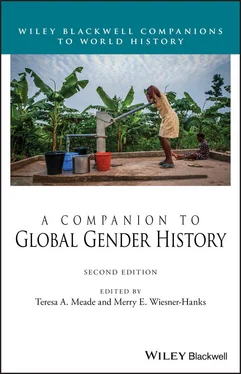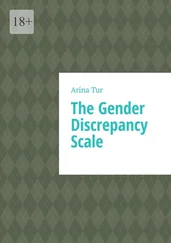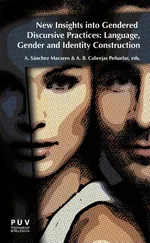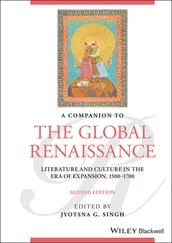Ultimately the question before us is still “who decides?” Cultural, societal, and moral norms exist and operate historically to regulate behavior and law, as Chapter 5by Susan Kent in this volume makes clear. While feminist and postmodern theories have challenged essentialist concepts, current scholarship often seems an intellectual minefield of issues about who can speak for the other and who has spoken rightly or wrongly in given historical eras. Feminist scholarship, critical race theory, class analysis, and global and world systems’ theories have questioned and challenged Western hegemonic assumptions and illusory universals. Sara Suleri critiques both the authority claimed by Western feminist theorists and the privilege assumed by postcolonial theorists on the basis of race. The first, she says, too often elides race in discussions of women and gender; the second too often gives special status to the racialized body as an “authentic” speaker. Suleri observes that “while feminist discourse remains vexed by questions of identity formation,” its reaction against assumptions of gender universality can grant “an unembarrassed privilege” to “racially encoded feminism” (1992: 758). Feminist discourse needs to guard against illusory assumptions of gender universals; however, too great a focus on the differences that separate women runs the risk of falling back into sexist and patriarchal rationales.
The January 2017 Women’s March was a pivotal day in the recent history of feminist consciousness. Centered in Washington DC, a city that housed a newly elected, very powerful opponent of women’s self‐determination, it spearheaded the voice of women across the globe. The March placed front‐and‐center the urgency of the demand for gender equality, at home, in the workplace, in the international arena, in the most private of all locales – the bedroom – and the most personal of all considerations – the human body. The tensions that arose over the subsequent two years drew a sharp picture of the divisions. Did the Women’s March signal a possibility of collective action by those who have already taken differences among women as a premise, or did it signal diversity and division so radical among women’s situations, experiences, issues, and perspectives as to foreclose genuine coalitions across racial, cultural, national, and sexual borders? The enormity of difference in women’s experiences is mindboggling – women in New Delhi fighting for legal protection for female sex workers confined by poverty and abandonment, women in East Africa fighting to change early‐marriage customs where girls as young as age four are given over to a husband’s family, women seeking to overturn customs that do damage to the female body, women struggling for economic and reproductive autonomy, for equal pay, educational opportunities, and respect. There is no question that each of us brought to the marches around the world our particular historical legacies and the ongoing consequences of those legacies. In the wake of the euphoria of that day in January the differences among us surfaced into hostilities. Two years later, many of the same women struggled to find common ground. Ironically, the breadth of our grievances brought together thousands of women and men across the globe in defense of women’s rights and gender equality. That spirit of united activism was no illusion. But those same issues and their differing effects brought to the surface divisions along racial, class, sexual, and national lines.
Yet with women everywhere still targeted with violence on the basis of gender, race, sexuality, and class, it seems that theory can ill afford to fragment and divide women. Certainly we are separated by our histories, experiences, privileges, and deprivations, but those who choose may be united in a willingness to transgress the borders that divide us. If feminist theory serves only to pronounce and reify our differences, rather than provide understanding of our different experiences and suggest ways we might form coalitions across the real and unnatural borders of our lives, then we will not break down the walls that history has built to contain us.
BIBLIOGRAPHY AND FURTHER READING
1 Alexander, M. Jacqui and Mohanty, Chandra Talpade, eds. (1997) Feminist Genealogies, Colonial Legacies, Democratic Futures. New York: Routledge.
2 Allen, Paula Gunn (1998) Off the Reservation: Reflections on Boundary‐Busting, Border‐Crossing Loose Canons. Boston: Beacon Press.
3 Anzaldua, Gloria (1999) Borderlands: The New Mestiza. 2nd edition, San Francisco: Aunt Lute Books.
4 Banton, Michael (1998) Racial Theories. Cambridge: Cambridge University Press.
5 Bhavnani, Kum‐Kum (2001) Feminism and “Race.” Oxford: Oxford University Press.
6 Boris, Eileen and Baron, Ava (2007) “The Body as a Category for Working Class History.” Labor 4 (2; Summer), 23–43.
7 Burch, Susan and Patterson, Lindsey (2013) “Not Just Any Body: Disability, Gender, and History.” Journal of Women’s History 25 (4; Winter), 122–37.
8 Butler, Judith (1990) Gender Trouble: Feminism and the Subversion of Identity. New York: Routledge.
9 Butler, Judith and Scott, Joan Wallach (1992) Feminists Theorize the Political. New York: Routledge.
10 Collins, Patricia Hill (1999) Black Feminist Thought: Knowledge, Consciousness, and the Politics of Empowerment. 2nd edition, New York: Routledge.
11 Collins, Patricia Hill and Bilge, Sirma (2016) Intersectionality. London: Polity.
12 Cook‐Lynn, Elizabeth (1996) “American Indian Intellectualism and the New Indian Story.” American Indian Quarterly 20 (Winter).
13 Crenshaw, Kimberlé (1989) “Demarginalizing the Intersection of Race and Sex: A Black Feminist Critique of Antidiscrimination Doctrine, Feminist Theory and Antiracist Politics.” University of Chicago Legal Forum 1, 139–66.
14 Crenshaw, Kimberlé, et al., eds. (1995) Critical Race Theory: The Key Writings that Formed the Movement. New York: New Press.
15 Feinberg, Leslie (1996) Transgender Warriors: Making History from Joan of Arc to Dennis Rodman. Boston: Beacon Press.
16 Frankenberg, Ruth (1997) Displacing Whiteness. Durham, NC: Duke University Press.
17 Garroutte, Eva Marie (2001) “The Racial Formation of American Indians: Negotiating Legitimate Identities within Tribal and Federal Law.” American Indian Quarterly 25(2; Spring).
18 Gordon, Linda (2016), “‘Intersectionality’, Socialist Feminism, and Contemporary Activism: Musings by a Second‐Wave Socialist Feminist.” Gender and History 28 (2), 340–57.
19 Hall, Kim F. (1995) Things of Darkness: Economies of Race and Gender in Early Modern England. Ithaca, NY: Cornell University Press.
20 Hausman, Bernice Louise (1995) Changing Sex: Transsexualism, Technology and the Idea of Gender. Durham, NC: Duke University Press.
21 Hesse‐Biber, Sharlene, Gilmartin, Christina, and Lydenberg, Robin (1999) Feminist Approaches to Theory and Methodology. New York: Oxford University Press.
22 Higgenbotham, Evelyn Brooks (1992) “African‐American Women’s History and the Metalanguage of Race.” Signs 17(2; Winter), 251–74.
23 Hillyer, Barbara (1993) Feminism and Disability. Norman: University of Oklahoma Press.
24 hooks, bell (2000) Feminism is for Everybody: Passionate Politics. Cambridge: South End Press.
25 “Intersectionality: Theorizing Power, Empowering Theory” (2013) Special issue of Signs 38 (4), 785–1055.
26 Keenan, Deirdre (2001) “Trespassing Native Ground: American Indian Studies and Problems of Non‐Native Work.” The Journal of the Midwest Modern Language Association 34 (1; Winter).
27 Liu, Tessie (1991) “Teaching the Differences Among Women from a Historical Perspective: Rethinking Race and Gender as Social Categories.” Women’s Studies International Forum 14 (2), 265–76.
Читать дальше












